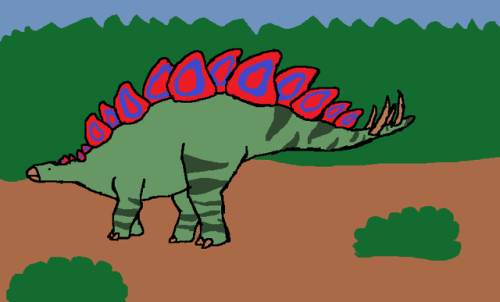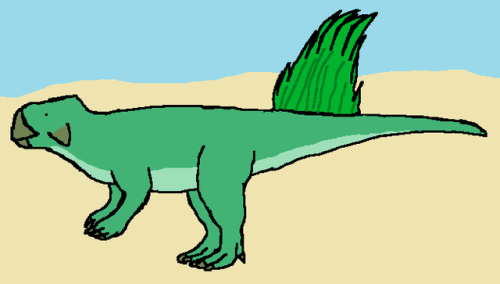#ornithischians
CORONOSAURUS
“Crown lizard”
Late Cretaceous, 77 million years ago
This ceratopsid was originally thought to be a species of Centrosaurus. But despite the requisite centrosaurine nose horn, plus additional barbs on its frill (“epiparietals”), Coronosaurus would still have had no trouble wearing a g*****n mask.
(:https://www.deviantart.com/pheaston)
Post link
Stegosaurus – Late Jurassic (155-150 Ma)
Y’all like dinosaurs?
Me too, and in an effort to talk about the more popular groups, today’s subject is Stegosaurus, the covered lizard himself. Stegosaurus is a staple of pop culture depictions of dinosaurs. Everyone who knows anything about dinosaurs knows Stegosaurus, and most of those people love it. The people who don’t aren’t worth listening to, in my opinion. Stegosaurus is a fascinating animal for a million reasons, but I’m going to try and narrow it down to my favorites.
Part of Stegosaurus’ reputation comes from how striking and easily-recognized it is. The deep, narrow torso, plates, and 3 foot long (!!!) tail spikes are immediately indicative that the animal you’re looking at is a Stegosaurus or something close to it. Even by dinosaur standards, this is an unusual body plan unique to the Stegosaurus family, and these traits have been endlessly scrutinized in an effort to understand what they were for. The plates were tall and flat, arranged in an alternating pattern on its back and numbering anywhere from 17 to 22. Well-preserved Stegosaurus plates are etched with branching grooves. Othniel Charles Marsh, the legendary paleontologist who discovered Stegosaurus, thought they were used as armor. But, the lack of coverage and overall fragility of the plates leads us to think they weren’t used for defensive purposes, but for display. The grooves housing blood vessels that could be flushed, reddening the thin layer of skin covering them. This could be used either as a mating display or as a warning to any predator trying to fuck with it.
The four parallel spikes on a Stegosaurus’ tail are informally called the “thagomizer,” named after a joke in a Far Side strip. It’s worth mentioning that this isn’t just a pop culture thing—scientists love calling it that. The thagomizer was a weapon, and a formidable one. Most big dinosaurs had hardened tendons in their tails, making them stiff and ideal for balancing their large bodies. Stegosaurus didn’t have these tendons, making its tail much more flexible than that of the average herbivore. It compensated with a sloping posture, with shorter forelimbs and long, thick hind limbs. These proportions aided in swinging its tail, allowing it to anchor itself with the back legs while pushing off with the front, giving the swing lots of power. Many preserved spikes have evidence of impact trauma, and an Allosaurus has even been found with punctures in the bone. As it happens, Stegosaurus spikes happen to fit perfectly into these punctures. So, unless the Allosaurus in question just kind of fell sideways onto a dead Stegosaurus or something, this all points to a weaponized tail. If it’s good enough for forensic scientists, it’s good enough for rockbonologists.
Is the idea that Stegosaurus had two brains still a thing? It was a thing when I was a kid, but I’m not sure if it’s fallen out of favor or not. This was something proposed by Marsh when he first described Stegosaurus, as an explanation for the big cavity in its hip region. Because Stegosaurus’ brain is so tiny, reasoned Marsh, a secondary brain in the hips added extra processing power. The problem is, this cavity isn’t unique to Stegosaurus—sauropods had it, as do a certain group of dinosaurs called birds. Now, in birds, the organ filling this space is a part of the spinal cord. It’s not a brain at all, but something called a glycogen body. This should be an easy win for us. If this organ is present in living animals, it was probably there for the related Stegosaurus too, and it probably did the same thing. That brings us to problem 2: Nobody knows what exactly glycogen bodies do in birds. They’re made of cells rich in glycogen, a vital sugar used for storing energy. Despite this, the glycogen body seems unrelated to normal glycogen functions, and is, essentially, a big question mark.
While we’re on the subject of brains, a lot of people think dinosaurs were stupid, and a lot of that comes from studies of Stegosaurus’ brain case, which was super tiny. Only the upper-back corner of the skull was devoted to brain room. That being said, stop calling Stegosaurus stupid—it’s mean and he doesn’t deserve it. He had a tiny walnut brain, sure, but his brain was just the size he needed it to be to eat shrubs and swing his tail around. Herbivores, on the whole, don’t need to be quite as intelligent as carnivores, and Stegosaurus was good at what it did.
Also, nobody knows exactly how Stegosaurus had sex. Think about it.
******************************************************************************
Buy me a Coffee, if you’d like!
Post link
Psittacosaurus – Early Cretaceous (126-101 Ma)
I’m a mess. I’ve been running this blog for a long time, and I barely talk about dinosaurs. I was thinking about the dinosaurs I’ve drawn, and I haven’t even covered most of the famous groups, including ceratopsians. Mess.
So let’s talk about a ceratopsian. Ceratopsians were the dinosaurs who looked like Triceratops; frill, facial horns, beak, etc. This little guy is named Psittacosaurus, which means “parrot lizard.” It was about the size of a golden retriever, and was a more basal sort of ceratopsian. It has no frill, only a ridge on the back of the skull. It had two spikes on its cheeks—one species even has horns protruding from the front of the skull, but it’s likely convergent evolution, not a directly ancestral trait for future ceratopsians. It was still a biped, though, even as an adult. Its remains are found in eastern Asia, from Russia, China, and famously, Mongolia. We’ve found hundreds of fossils of 11 different species and from all stages of life. This is one of the dinosaurs we have an almost complete image of.
Psittacosaurus was an efficient little herbivore, with a tough beak and a battery of self-sharpening teeth. Desert plants tend to be hardier and thicker, and these teeth let it slice through those tough desert plants without a problem. It also swallowed stones to aid the digestion process. This is a behavior seen in many herbivores today. Plants are kind of hard to digest, so plenty of animals swallow rocks to help grind up their food. Psittacosaurus had big eyes and, surprisingly, a pretty big brain. They built nests and took care of their hatchlings. They were probably comparable to a sparrow in terms of intelligence, which is a reminder that despite popular thought, dinosaurs weren’t stupid.
Speaking of bipedalism, this animal has kind of a weird relationship with the concept of walking on two legs. Its young may have been quadrupedal, suggesting it evolved from a quadrupedal ancestor. So, this means one of two things: 1) Ceratopsians evolved from quadrupeds, became bipeds, and then went back to walking on all fours, or 2) This is a more derived ceratopsian that branched off from the line leading to the big guys from later on. The former isn’t as wacky as it sounds—other animals have done it in their history. The latter is just as likely, though. This sort of thing is really hard to determine in animals who are a hundred million years old.
Unlike its descendants, Psittacosaurus was agile and quick on its feet. Later ceratopsians were more like tank builds. When something wanted to eat a Triceratops or its babies, it’d hunker down and wave its horns and frill and warn the predator to piss off. But in Psittacosaurus’ case, it was the one doing the pissing off. It was small, so it makes sense that it would want to run away instead of trying to fight. We’ve also learned, through molecular studies, that its skin was countershaded. Countershading is a type of camouflage common in a lot of animals, where the top half of its body is dark, and its belly is lighter. This makes it harder to see them by messing with their shading. Deer, dolphins, and manta rays are some of the many animals that do this today. Psittacosaurus likely depended on this to avoid being spotted by theropods, who hunted primarily with eyesight.
Another cool thing we learned about this guy fairly recently is the brush of quills on its tail. Now, this is kind of weird for a few reasons. Dinosaurs are divided into two big groups, Ornithischia and Saurischia. Birds originated in Saurischia, and many, many Saurischians had feathers. The exception is sauropods, although they might have had quills on their back. It makes sense to think that feathers originated in this branch.
BUUUUUUUUUUUT
A few groups of Ornithischians had quills, like Psittacosaurus. So, it’s been proposed that feathers are an ancestral trait for all dinosaurs, and that the most recent common ancestor of all of them was at least fuzzy. Although, the quills in Psittacosaurus were different from those of their distant birdlike cousins. They had a conelike structure and might have been filled with some sort of fluid. They may have even been covered in keratin, making them quite different from what we usually call ‘feathers.’ They’re also only found on a very particular and unusual part of the body. The most convincing study on these weird quill things has concluded that they aren’t really similar enough to be considered homologous to theropod feathers, and probably evolved independently. Mind you, we don’t know for sure, and fuzzy Coelophysis isn’t completely unreasonable. Given sauropods may have had quills, maybe those were the ancestral structure, and theropods just went buckwild with them.
Also, this means Triceratops may have had a sparse smattering of quills on its butt, which I like a lot. I’ll draw a bigger ceratopsian with quills at some point and it’ll be a fun time.
One more thing about Psittacosaurus, and it’s not really particularly scientific, but this thing is SO CUTE. I want one as a pet. Maybe it would be kinda spiky, and maybe it wouldn’t be great for petting, but I think it would be a good friend.
That’s all for today’s animal, a dinosaur whom I love very much. I think from now on, I will make more of an effort to draw more famous dinosaurs, because a lot of them are well-known and I like a lot of them. I just don’t want to get it all out of my system at once, you know?
******************************************************************************
Buy me a Coffee, if you’d like!
Post link



